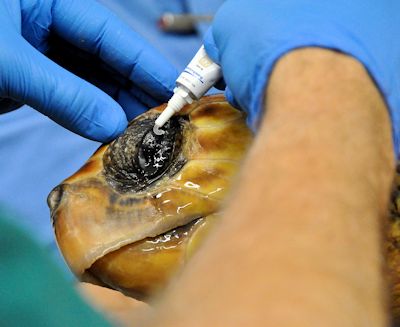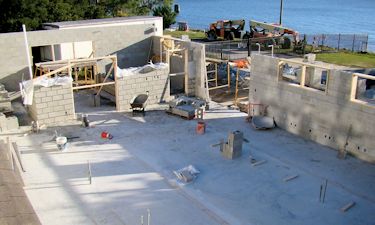Reprinted from the Outer Banks Voice
MANTEO — With construction well underway, the N.C. Aquarium on Roanoke Island is expected to open its improved Sea Turtle Assistance and Rehabilitation Center, or STAR, sometime in mid-2014, according to aquarium curator Christian Legner.
Supporter Spotlight
The state Department of Environment and Natural Resources is paying for the 3,000-square-foot center, which is being built in partnership with the Network for Endangered Sea Turtles, or N.E.S.T. Aquarium officials say they hope to occupy STAR next month to begin outfitting it for operation.

A turtle receives treatment at a rehabilitation center at a N.C. Aquarium. Photo: N.C. Aquariums |
Legner said the facility should be up and running no later than early summer.
It will outshine the current turtle rehab center. It will have more space and state-of-the-art exhibits that will engage the public in the rehabilitation process. Currently, aquarium workers and N.E.S.T. volunteers operate out of a small outbuilding at the aquarium site that Legner says is about three times smaller than the building now under construction.
“We just keep taking turtles until we are full to the brim,” Legner said. “Last year, we had more than 70 turtles.”
Supporter Spotlight
When the facility becomes overcrowded, turtles are shipped to other rehab centers in the state. The new facility will significantly reduce the need to transport turtles out of the area, which reduces the stress on the animals during their rehabilitation.
STAR will include key equipment to allow veterinarians to treat the turtles on-site, more treatment space and increased options for housing the turtles, Legner said. It is being built off the current Operation Sea Turtle Rescue exhibit on the sound side of the aquarium and will include a separate treatment exam room with a large window for public viewing.
The current facility is often overcrowded.
LCD screens will also be installed to post information for visitors about current patients.
The new center also will feature technology to enable N.E.S.T. volunteers and aquarium staff to answer questions from visitors as they work on the turtles.

The new center will provide three times more space than the area now being used. Photo: N.C. Aquarium on Roanoke Island |
“There will be a lot of new graphics and interactive exhibits for the public,” Legner said.
The aquarium and N.E.S.T. will continue to work together to respond and treat cold-stunned turtles in the winter months and injured or sick turtles throughout the year. Once turtles are treated by a veterinarian, they are transported to the rehab center until they are healthy enough to be released into the ocean.
The new facility will include holding tanks for recuperating turtles, food preparation areas, storage space and a large medical treatment room. An advanced filtration system in the tanks will give caregivers the opportunity to provide turtles with better care, according to Legner.
A strong education component will be included in the new facility with the large window and interactive displays.
“Visitors will now get a behind-the-scenes look at us working with the turtles,” Legner said.
N.E.S.T. partners with the aquarium by providing frontline response to turtles in distress as well as funding veterinary bills and volunteering seven days a week at the turtle rehabilitation center. The aquarium foots the bill for room and board as well as some medical expenses and staffing, Legner said.








